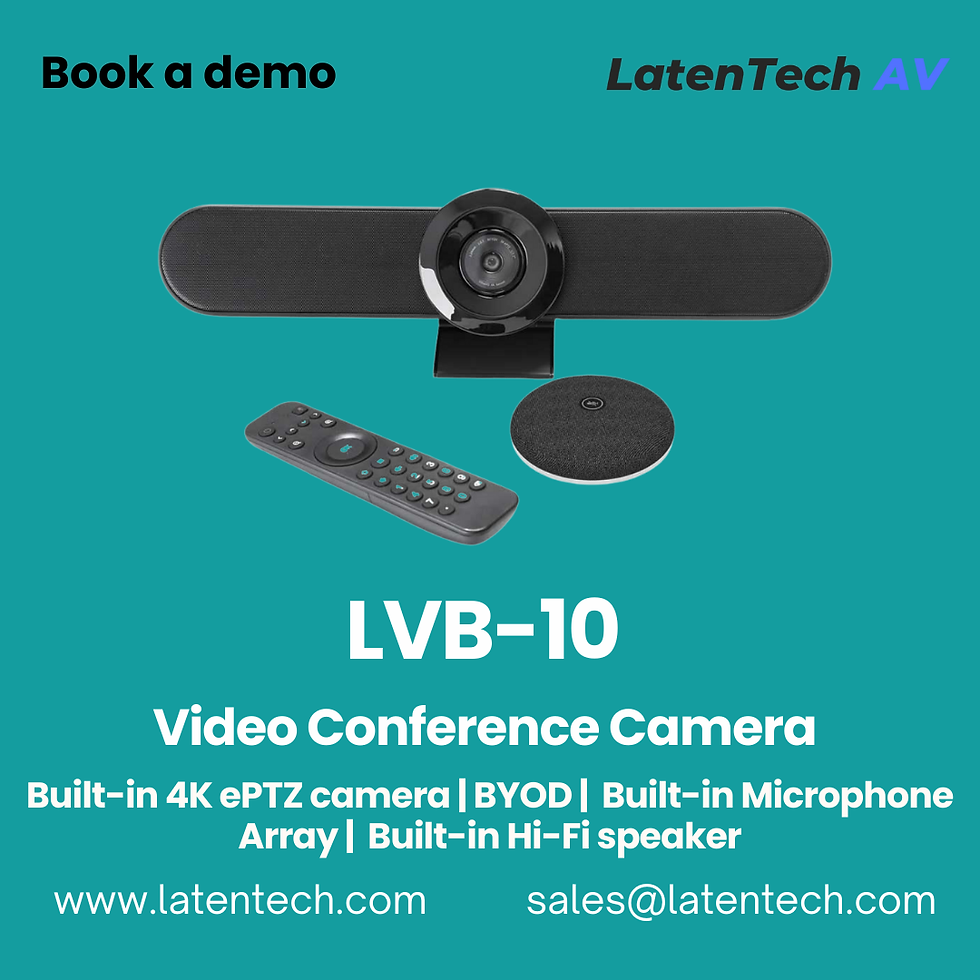LatenTech AV LVB-10 BYOM Video Bar: A Closer Look at 2025’s Best Meeting Room AV Tech
- LatenTech AV

- Sep 15
- 3 min read
Updated: Sep 16
The LVB-10 from LatenTech AV is an all-in-one video conferencing / collaboration video bar designed to facilitate modern hybrid & remote workplaces. The “BYOM” (“Bring Your Own Meeting”) tag suggests that it supports using whatever video conferencing platform or device the user prefers (laptop, tablet etc.), rather than being locked into a proprietary system.
It aims to Integrate camera, microphones, speaker(s), audio-processing, video output, and perhaps wireless display or screen sharing, in one chassis, simplifying room setups and reducing clutter.
Key Features & Specifications
While specific publicly available data on LVB-10 is somewhat limited, drawing from LatenTech AV’s offerings and what similar video bars provide, here are expected features (some inferred / probable) and known design elements:
Usage Scenarios & Benefits
Flexibility & Compatibility: With BYOM, teams can use the meeting software they prefer; no need to purchase multiple dedicated room licenses. Good for organizations with mixed platform use.
Reduced Complexity: Fewer devices to install, fewer cables, simpler maintenance. Integrated audio/video processing means less chance of mismatch between separate mic / speaker / camera components.
Better ROI in Mid-Sized Rooms: For meeting rooms that are too large for simple webcams but too small for elaborate AV setups, this kind of video bar gives good bang for buck.
Improved Meeting Experience: Wide-angle coverage, AI framing/tracking, good audio can make remote participants feel more included; reduces disruptions and improves clarity.
Scalable Deployment: Easier to deploy across multiple rooms/offices given the simpler hardware, potentially lower cost per room.

Potential Drawbacks / Considerations
Acoustic Challenges: Even with noise suppression and echo cancellation, large rooms or rooms with poor acoustics (glass, hard surfaces) may still suffer echo, reverberation, or poor audio pickup. Additional mics or acoustic treatment may be needed.
Lighting and Camera Quality: Even a good 4K lens can be limited by lighting; low-light performance or harsh lighting could reduce video quality. AI enhancement helps but has limits.
Integration Limitations: If the video bar uses generic USB/HMDI or wireless design, some advanced integrations (room scheduling touch panels, dedicated hardware codecs, etc.) may not be possible. Also, performance depends on the user’s meeting platform and computer hardware.
Cost vs Features: Depending on the pricing, similar video bars from big brands may offer more polished software support, longer warranty, better ecosystem integration. Buyers need to check total cost of ownership.
Firmware / Support: For AI & voice features, firmware/software updates are crucial. Support, latency, reliability need to be evaluated.
How It Compares
While direct metrics for LVB-10 are sparse, LatenTech AV’s prior models (like the LVB-5) show their design direction: 4K AI video bars with wide angle (≈116°), multiple mics, speaker-design, echo cancellation, etc. Imimg
Thus, the LVB-10 would presumably build on that with enhancements (e.g. better range, improved AI, more input/output options, possibly Wireless Display or Screen Sharing, improved beamforming mic arrays etc.).

Who Should Consider the LVB-10?
Companies or organizations with Multiple Meeting Rooms wanting standardized, simple, high-quality video/audiosystems without having to buy full hardware/software suites per room.
Hybrid workplaces where some participants are remote and clarity of video + audio matters.
Environments where BYOM is desirable (e.g. no desire to lock into one vendor’s cloud or room-based software).
Medium size rooms (say 4-10 people) rather than large boardrooms unless augmented.

Conclusion
The LatenTech AV LVB-10 BYOM video bar represents a strong offering in the all-in-one conferencing hardware space: combining camera, mics, speaker, and intelligent processing in one unit. Its BYOM philosophy gives flexibility, and for many offices this kind of product strikes a good balance between cost, functionality, and simplicity.
If you’re evaluating it, I’d recommend requesting a demo, looking at real-world performance in the lighting and room acoustics similar to yours, checking compatibility with your conferencing platform, and ensuring post-sales/firmware support is robust.
Discover more about the LVB-10:🌐 www.latentech.com




Comments